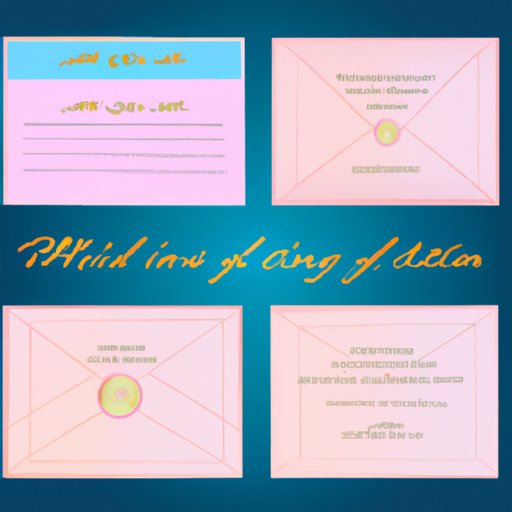Introduction
Wedding invitations can be daunting for many couples. It’s a lot of pressure to make sure you get it right and that all your guests feel included and respected. This is especially true when you are addressing your invitations to a family. You want to make sure that everyone in the family is properly addressed. To make this task easier, we have put together a step-by-step guide on how to address wedding invitations to a family.
Step-by-Step Guide on Addressing the Envelope
The first step is to decide who you should include in the envelope. Generally, you should include all adults who live in the household, but if there are any children or teens, they should also be included. It is important to note that if any of the adults in the household have different last names, they should still be included in the same envelope.
Once you have decided who to include, the next step is to format their names correctly on the envelope. For married couples, the traditional way is to list the wife’s name first, followed by the husband’s name. If the couple has different last names, the names should be listed separately. For unmarried couples, the names should be listed side by side.
When addressing invitations to children and teens, you should use their full names. If they do not have a middle name, it is not necessary to add one. If they are under 18 years old, they should be listed after their parents’ names.

Proper Etiquette for Addressing Wedding Invitations
Once you have decided who to include and formatted their names correctly, it is time to consider the wording of the invitation. There are two main types of wording – formal and informal. Formal wording is typically used for more traditional weddings and includes titles like Mr., Mrs., and Dr. Informal wording is more commonly used for more casual weddings and does not include titles.
When using formal wording, it is important to include titles and honorifics such as “Mr.” and “Mrs.” as well as any special titles such as “Dr.” or “Reverend.” It is also important to include any abbreviations such as Jr. or Sr. Lastly, it is important to use proper punctuation such as commas and periods.

Tips on How to Address Invitations to Large Families
Addressing invitations to large families can be tricky. The key is to make sure that everyone in the family is included. One way to make this easier is to group the invitations together. For example, if you are sending an invitation to a family of four, you could group the invitation to the parents together and then list the children’s names separately. This makes it easier to keep track of who has been invited.
Another tip is to simplify the wording. This is especially helpful for large families since there may be a lot of names to include. Instead of listing out each individual name, you can simply list “The Smith Family” or “The Joneses”. This is a much simpler way to include everyone without having to write out all the names.
How to Address Invitations to Blended Families
Addressing invitations to blended families can be even more complicated than addressing invitations to large families. The key is to identify the hosts of the wedding and then identify each spouse. For example, if the bride’s parents are hosting the wedding, then the invitation should be addressed to “Mr. and Mrs. John Smith and Mr. and Mrs. William Jones”. If both sets of parents are hosting the wedding, then the invitation should be addressed to “Mr. and Mrs. John Smith and Mr. and Mrs. William Jones and Mr. and Mrs. Robert Miller and Mrs. Elizabeth Miller”.
When addressing invitations to blended families, it is also important to remember to include any children from previous marriages. If the children are over 18 years old, then they should be listed separately after their parents’ names. If the children are under 18 years old, then they should be listed after their parents’ names.

Examples of Different Formats for Addressing Invitations
There are various ways to address wedding invitations, depending on the style of the wedding and the size of the family. Here are some examples of different formats you can use:
Traditional Format: Mr. and Mrs. John Smith and Family
Contemporary Format: John and Jane Smith, and Family
Creative Format: The Smiths and Their Littles
Conclusion
Addressing wedding invitations to a family can be a challenging task, but it doesn’t have to be. By following our step-by-step guide and keeping in mind proper etiquette and formatting, you can ensure that all members of the family are properly included. We hope this article has been helpful in guiding you through the process of addressing wedding invitations to a family.


